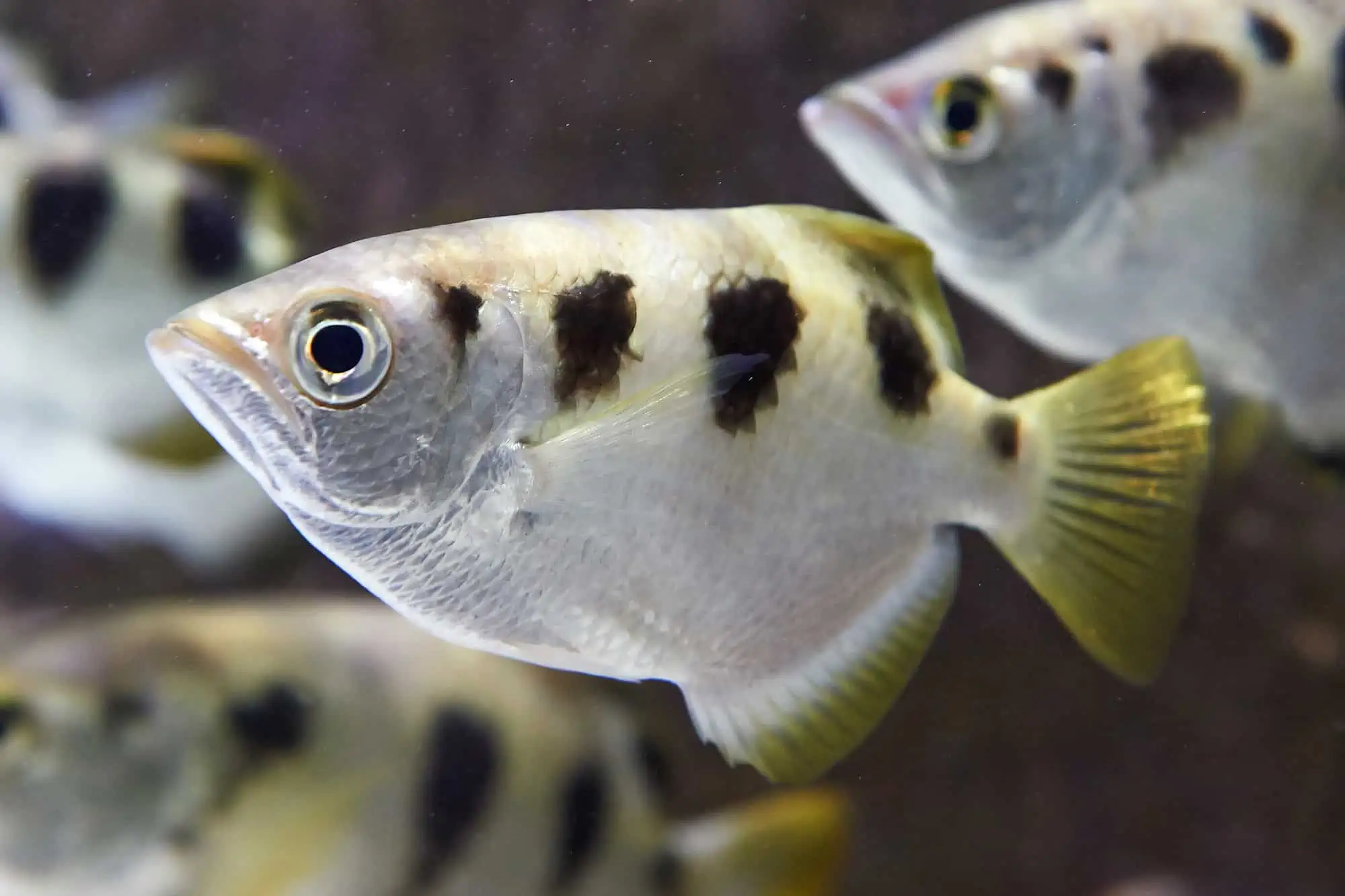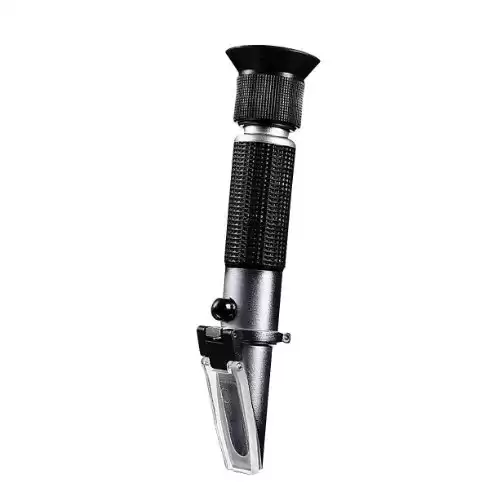[ad_1]
From my childhood trip to The Sea Life London Aquarium, one fish captured my imagination more than all the rest. That fish’s name is the archerfish, and it has evolved a hunting strategy unlike any other.
I watched spellbound as they pursed their lips to the water’s surface and spat jets of water into the branches above their tank. I was even more excited to learn that you could also keep archerfish at home, though I didn’t realize then just how hard keeping them can be.
Since they’re often mistreated and die prematurely in home aquariums, I’ve gone to extra lengths to produce the best archerfish care guide on the internet.
Species Overview
Archerfish are so-called because of their dazzling ability to shoot down terrestrial prey above the water by ejecting a stream of water from their mouths. These water jets sometimes reach 6-10 feet in range, and according to scientific research, experienced archerfish rarely miss a shot.
Because this astonishing behavior needs to be seen to be believed, I highly recommend watching this 3-minute clip of archerfish bringing down spiders from overhanging branches in Australia.
Not only do archerfish spit down their prey, but they’re also superb jumpers and often leap out of the water to snatch up their prey directly. Recent scientific research has revealed that archerfish use water jets to hunt underwater invertebrates at closer range, too.
With this fascinating behavior, it’s hardly surprising that aquarists wanted to keep archerfish at home, but these challenging fish require a specialist tank set up to meet their specific needs.
Archerfish Origins and Habitat
Archerfish come from the tropical east and can be found swimming wild in Northern Australia, Southeast Asia, and the Indian Subcontinent.
Archerfish are often considered brackish water fish because some of the most famous species often dwell in mangrove swamps. Other species of archerfish, however, are freshwater fish, so let’s explore the differences between them.
The Different Types of Archerfish
Archerfish aren’t just one type of fish, but a family of nine separate species. Only a few of them have been studied closely, and just three are commonly kept in home aquariums.
Archerfish species are often mislabelled in pet stores because they’re difficult to tell apart.
- According to Frank Schaefer, (author of The Aqualog brackish book), Toxotes microlepis, the smallscale archerfish, is the most commonly imported archerfish in the USA. They are the most suitable for home aquariums because they are much smaller than the other two species and can also be kept in freshwater.
- T.jaculatrix, the banded archerfish, is a much larger fish than T.microlepis, but slightly smaller than T.chatareus. Unlike the other species, it has 4 dorsal fin spines, instead of 5 like the other species. It typically has four to five vertical bands without blotches between them.
- T.chatareus, the largescale archerfish, has seven less-defined vertical bands that are often broken up into smaller blotches. True to their name, they also have noticeably larger scales than the other species.
According to Neale Monks, a leading authority on brackish water fish, there are several other members of the family that can be kept in freshwater, too:
Toxotes blythii (highly sought-after), Toxotes lorentzi, Toxotes oligolepis, and Toxotes kimberleyensis can all be kept in alkaline freshwater aquariums but less is known about them, and they are harder to find than the three species above.
Archerfish Appearance and Size
Aside from the bands and blotches that I just described, archerfish are a unique-looking family. With a deep, shiny, silver stream-lined body and a sharply pointed snout, they’re formidable-looking fish that ooze with speed and power.
Interestingly, archerfish colors can change with time, and many fish keepers report their archerfish turning a darker color at times. It’s unclear exactly what color changes indicate, but some have theorized that a darkening color can be connected with ill health or stress.
In the wild, T.jaculatrix can reach a maximum length of 12 inches (30cm), whereas T.chatareus can reach 16 inches (40cm). In aquariums, both species only tend to reach about 8 inches in length, although T.chatareus tend to grow marginally bigger.
The smaller and more peaceful fish T.microlepis only reaches a maximum length of 15 centimeters (5.9 in) in the wild and often slightly less in aquariums.
Sexual dimorphism is yet to be well-documented in archerfish.
Archerfish Care Guide
Tank Type
The first thing to understand about caring for archerfish is that they’re highly specialized fish, with unusual requirements in the way they like to be kept.
Brackish Water or Freshwater
Some species of archerfish need to be kept in brackish water, while others can live in freshwater.
Of the three commonly kept species, only T.microlepis is happy in (alkaline) freshwater aquariums for extended periods of time but can be kept in mildly brackish water, too.
In the wild, T.jaculatrix, and T.chatareus move between freshwater, brackish water, and saltwater. They spend most of their time in river mouths and mangrove estuaries though, so need an aquarium with brackish water (see water parameters for details).
Paludariums, Ripariums, or Feeding While Changing Water
Because of their specialized hunting technique, many aquarists like to permanently keep archerfish in a tank that’s only partially filled with water where they can jump and shoot down their prey from overhanging branches.
Alternatively, you can let them display their unique hunting behavior once a week by reducing the water level during water changes. Here are your 3 main options:
- A Paludarium – an amphibian or fish tank that is only partially filled with water. The upper sections can include emersed plant growth, branches, or even dry land. Find out more in our guide to paludariums here.
- A Riparium – similar to paludariums, except they tend to have more water, with only the very upper reaches of the tank not submersed.
- A regular topped-up aquarium that’s emptied by 30% each week for partial water changes. With the top third empty, you can stick pieces of shrimp or fish onto the glass. The archerfish will smell them and shoot them down!
Although less commonly seen, Neale Monks is a big advocate of this last method because it gives the fish the most swimming space for the rest of the time. More water also provides a greater buffering capacity and so tends to help quality water remain more stable.
Keeping Archerfish Alone or in a School
In the wild, archerfish are schooling fish, apparently with a strict social hierarchy. In the wild and public aquariums, they’re sometimes seen swimming in a long line, apparently with the alpha fish leading the rest of the pack.
Because home aquariums are too small for this, their schooling behavior may become more chaotic, with aggression between fish.
According to Neale Monks, archerfish should only be kept alone or in groups of at least 6 fish. In smaller groups, the weaker fish will often get bullied or even killed by larger ones.
Keeping other similar-sized fish can also help to disperse aggression, and Monks reports that Green Chromides (Etroplus suratensis) cichlids are especially good at this.
Tank Size
Your tank size depends on how many archerfish you’d like to keep, and whether you’d like to keep them in a paludarium or a fully-filled aquarium.
Individual fish need at least 55 gallons of water, and for the minimum school size of 6 archerfish, you’ll need at least a 100-gallon tank filled to the top.
Larger tanks are necessary if they’re to be permanently left half-full.
Tank Environment
If you wish to keep your archerfish in a paludarium or riparium, the upper reaches of the tank should include some overhanging branches or vegetation in which insects can crawl and fly about for your archerfish to feed on.
Aside from that, archerfish are active fish and need plenty of open water to swim about freely. Sparse planting could include tough plants like Anacharis, Java fern, Anubias, and Crypts. Remember that most freshwater plants can tolerate mildly brackish water, too.
Always be sure to keep a tight-fitting tank lid to prevent archerfish from jumping out of their tank!
Water Temperature

Archerfish are tropical fish that enjoy even warmer water temperatures than most species. Your aquarium heater’s thermostat should be turned up to at least 78°F, and some sources report that these surface-dwelling fish do well in temperatures anywhere up to 87°F.
Remember that warmer water contains less dissolved oxygen, so you’ll need good filtration and plenty of agitation at the water’s surface to ensure a constant oxygen supply. Alternatively, you could install an airstone or bubbler.
Water Parameters
If you want to keep archerfish in brackish water, you’ll need a piece of aquarium equipment known as a refractometer or hydrometer.
According to Frank Schaefer’s brackish fish book in 2005, archerfish are tolerant to the following salinity concentrations:
- 1.010 to sea water: Toxotes jaculatrix
- 1.005 to 1.010: Toxotes chatareus
- Fresh to 1.005: Toxotes microlepis, Toxotes oligolepis
- Strictly Freshwater: Toxotes lorenzi, Toxotes blythii
If you’re using high-quality aquarium salt, it should take care of the pH and hardness of the water, but archerfish should always be kept in water between pH 7.2 – 8.2.
Filtration
Because archerfish need a large aquarium and excellent water quality, canister filters are your best option. Although more expensive, canister filters clean aquarium water more efficiently than other types of filters, and also tend to be quieter and require less maintenance.
As strong swimmers, archerfish will have no trouble swimming against a strong filter flow, and may even enjoy it.
Feeding
One of the most interesting but sometimes challenging things about keeping archerfish is their eating habits.
As we’ve already covered, archerfish naturally source much of their prey such as spiders, insects, and other invertebrates from above the water, either by spitting or jumping.
Because they always come from wild stocks, archerfish may be slow to recognize dried fish foods like fish flake food or sinking pellets as food at all.
Crickets, mealworms, and even house flies are common items that aquarists offer their archerfish to shoot down and devour. Small pieces of fresh fish and squid placed above the water line will also be relished!
With practice, archerfish will often begin to accept frozen foods and high-quality fish pellets. Neale Monks recommends Hikari Gold or high-quality cichlid pellets.
Compatible Tank Mates
Another important consideration for keeping archerfish is compatible tank mates. Archerfish are athletic, semi-aggressive fish that will happily snap up any fish that are small enough to fit in their huge mouths! They also like to spend most of their time near the water surface, and so may be especially territorial in the upper water layers.
Your best choice, therefore, is other medium-large fish that are neither too aggressive nor too docile, and inhabit the middle or lower water layers rather than the surface.
If you’re keeping archerfish in a brackish setup, you’ll need to choose other brackish water fish. Scats, pufferfish, and monos are popular choices, and in a paludarium with a dry bank, you could even add mudskippers, too!
Whether you’re keeping archerfish in a freshwater or brackish aquarium, Neale Monks highly recommends Green Chromides (Etroplus suratensis), a beautiful, medium-large but fairly peaceful cichlid that can tolerate a wide range of water conditions.
In freshwater, larger Australian rainbow fish, silver dollars, clown barbs, clown loaches, and large catfish like plecos are good companions for smallscale archerfish.
Health and Disease
Because archerfish are not such a commonly kept species, their disease susceptibility is not yet well documented. What is clear is that archerfish regularly get sick and die prematurely in home aquariums.
The leading cause of ill health is probably incorrect water parameters. With a lot of misinformation on the internet, as well as the mislabelling of the different species, people often keep archerfish at incorrect salinity.
Additionally, archerfish also demand clean water with high oxygen levels to remain in good health. Good tank maintenance and efficient filtration, therefore, are essential.
Another common health concern is fighting among archerfish. Fighting and bullying are often caused by mixing different species, keeping them in schools that are not large enough, or keeping them in tanks that are too small.
Bullied fish can easily die from injuries, or become stressed and prone to health problems.
Lifespan
Well-cared-for archerfish typically live from 6-8 years in a home aquarium, with individuals occasionally exceeding 10 years in captivity, too.
For them to reach their maximum lifespan, their diet, water quality, and level of care must be of the highest order.
Tank Maintenance
Some top tips for keeping your archerfish in tip-top condition:
Breeding Archerfish
Archerfish have been bred in captivity on a few occasions, but it’d be a wildly ambitious endeavor for the home aquarist to try! For starters, reliable methods to sex the fish are yet to be published.
Archerfish Buying Guide
Because the archerfish in the aquarium trade are caught in the wild, supplies of each species can be sporadic, leaving dry periods where it’s difficult to source certain types.
If you do see archerfish in a pet store, never trust the labels that describe the species! Do your own identification based on the information in this article. Since each species has its own care requirements, it’s essential that you know which type of archerfish you’re getting!
Here’s a reminder based on Frank Schaefer’s book:
- 4 dorsal fin spines = Toxotes jaculatrix
- 5 dorsal fin spines = go to 3
- An additional small dark spot on the dorsal region between the dark stripes = Toxotes chatareus
- Fewer than 30 scales along the flanks (lateral line) = Toxotes oligolepis
- More than 30 scales along the flanks (lateral line) = Toxotes microlepis
You can expect to pay anything between $15-45 for individuals of the more common species, and upwards of $50 each for the rarer species.
Final Thoughts
Archerfish must be one of the most fascinating fish to keep in an aquarium but are definitely not for the beginner fish keeper. These unusual pet fish need a specialist tank set up to thrive and often die prematurely at the hands of inexperienced aquarists.
If you’re serious about keeping archerfish, I’d thoroughly recommend Neale Monk’s acclaimed book: Brackish-Water Fishes: An Aquarist’s Guide to Identification, Care & Husbandry as essential reading before buying your fish.
[ad_2]
Source link


